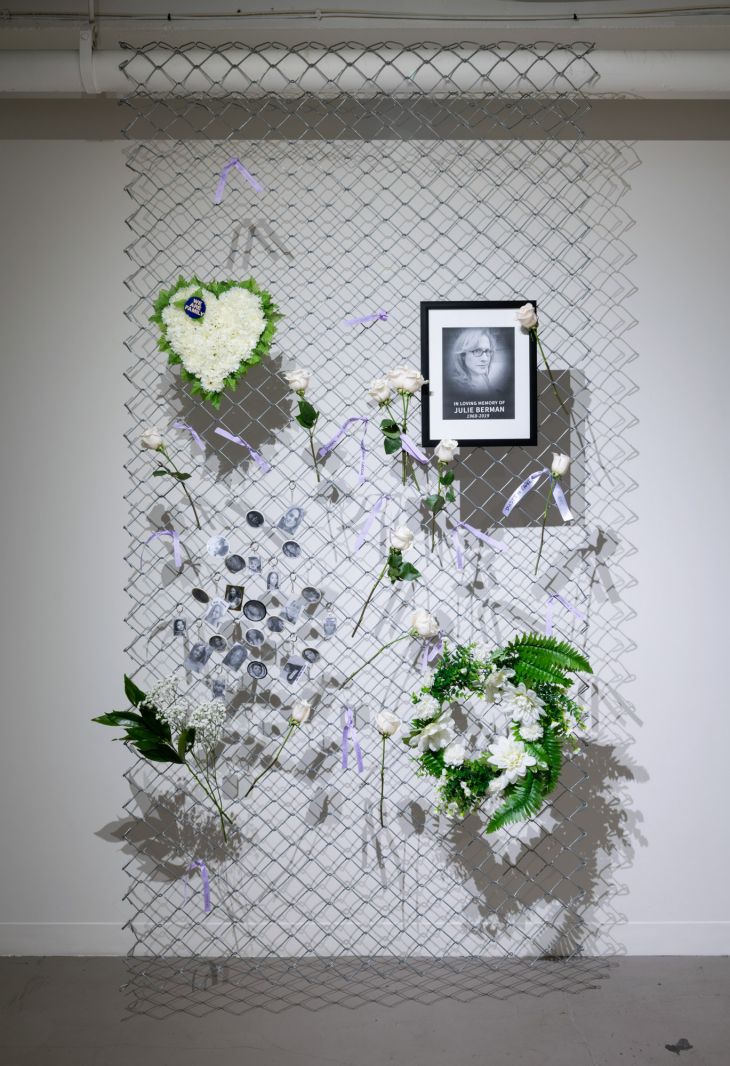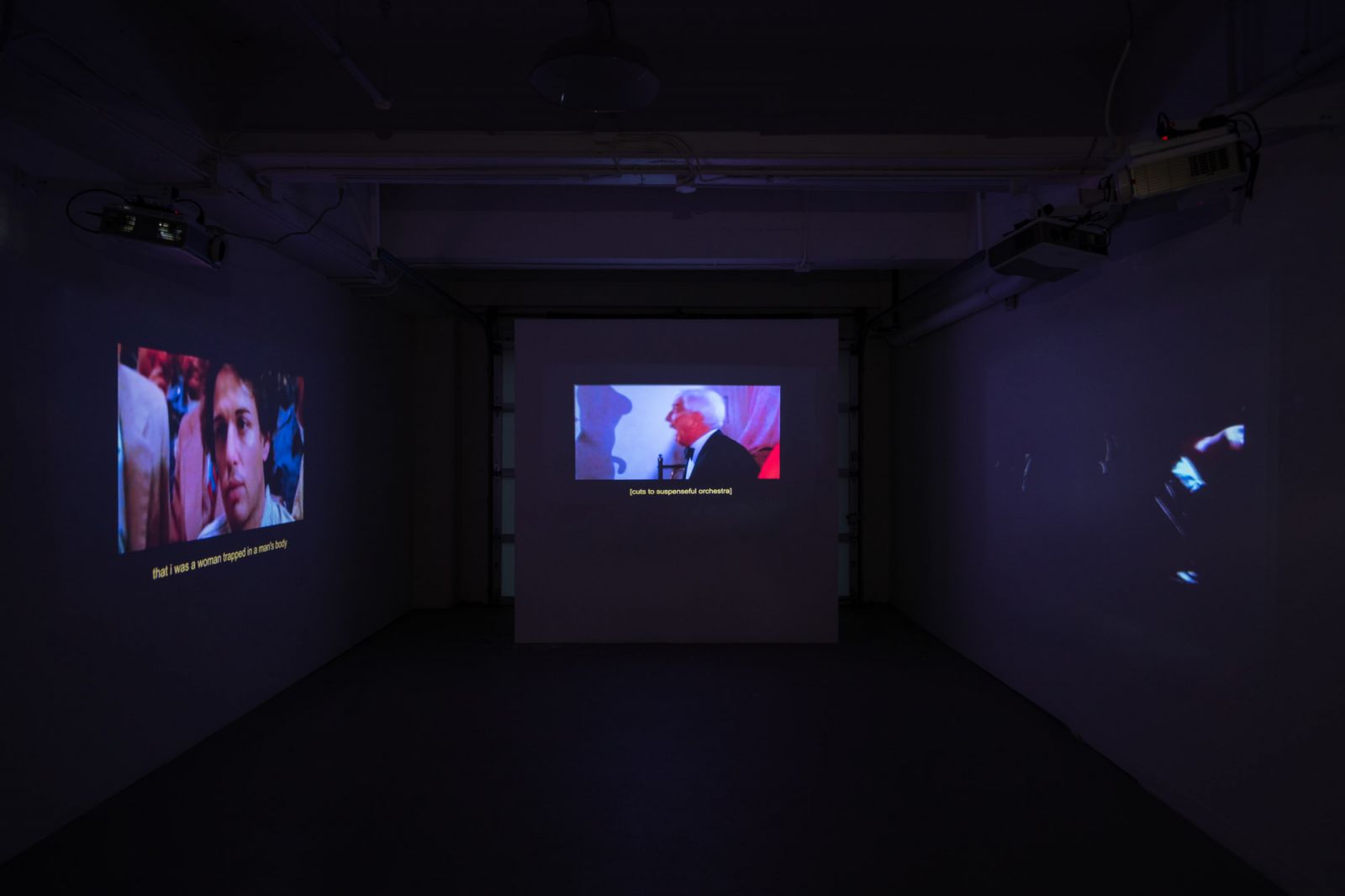JH: I want to go back to asking you about your art practice in particular the work, A Thousand Cuts. When I saw that work, I immediately thought, wow, what an amazing work of research and classification in order to create that video.
BGO: Yes, it’s very tedious. Again, I like that kind of work (laughs).
JH: Yes, it’s such an immense research undertaking. Can you talk a little bit about your process in putting together the video?
BGO: That work has been ongoing. I feel like it’s finally wrapping up in a way where I am getting ready to show it in places on a more finished scale. I’ve shown it in a couple of places, due to the censorship that ensued from Arts Commons in Calgary last September, but the piece has been ongoing since November 2016. I was working at the Banff Centre and I had some time to work on my own practice. I had one day out of the week. I was just getting increasingly frustrated – like most trans people I know – of reading in the news over and over again, of trans women – specifically trans women of colour, being murdered in the States and worldwide — and just,when you go through the counts and they do that at the end of each year for trans day of remembrance. And it’s just hundreds and hundreds each year and those are only the ones that are documented. So, my motivation stemmed from the frustration and grief I’ve been feeling over the negative representation of trans people in the media, and how violence against trans people is sensationalised but not actually addressed in a way that is helping trans communities.
I just started compiling clips of negative or false trans representation in film and video – all the clips are cisgender actors playing trans roles in popular film and television. There is one or two where they are playing drag queens or female impersonators. It’s a fine line of what clips should be included, so I always go over it and think about revising it. But all in all, it’s about trans identity being seen as this comical performance rather than something that is real. Transness is often portrayed as a homogenous identity marker: men in dresses, or confused/deranged people. So the whole point is to just draw a very hard connection between trans representation and violent realities. This project is for everyone, but in different ways. Cisgender people see all these movies and TV shows constantly without even thinking twice about the false representations they provide. And I mean I consumed all that media too. A lot of it is stuff I enjoy, like Hedwig and the Angry Inch. The work started off as a small three channel video compilation and I’m trying to work it into being a bigger installation piece to make it more immersive. I have someone working on the audio and I am showing it in Portland in November –which is really cool – at Fuller Rosen Gallery and hopefully I’ll get some feedback about that. So yeah, it’s a very archival piece. I am aware of the connections and I do that a lot.
JH: One of the parts that really struck me in the piece is one of the very last clips that shows Hillary Swank receiving the Oscar and saying how far we’ve come.
BGO: It’s very cringy….
JH: It is very cringy and so ironic. I remember watching that moment, on the Oscars, when it happened, and everyone is celebrating something that’s actually doing damage to people and contributing to negative representation of trans people.
BGO: Yeah, that’s a whole other story – the Brandon Teena case where there is just so much negative media coverage. You know, ‘a girl trying to be a boy’. No, his name is Brandon Teena. This is all transphobic violence that is happening with The Brandon Teena Story documentary (1998) and Boys Don’t Cry (1999) with Hilary Swank. You know, the announcer stated that “she lived as a boy for one month to prepare for the role.” But it doesn’t mean anything, because you are not a boy, you don’t come from a trans experience. There are a lot of people who disagree, who will say “well if it’s a positive representation, if the actor does the part well, does it matter if they are trans?” To me it does matter, because at this point trans people are just getting their foot in the door for non-trans roles, where they can take on roles as just people, where gender identity isn’t the focus. When trans people stop being murdered and dehumanized, it will matter less. But no, at this point, cisgender people should not be playing trans roles.
JH: Well it’s not like they have a lack of their own roles.
BGO: They have a lot to choose from.
JH: I am wondering if we could talk about Arts Commons and the censorship, if you want to talk about that.
BGO: That was interesting. It was right when I started my Masters program in September, so that was really stressful. I showed the work at the New Gallery[1] in Calgary, and they were very supportive and excited to exhibit the piece. They also spoke on my behalf, with Arts Commons during the censorship stuff, because I was in school and couldn’t fly out to deal with any of this. The +15 Window Gallery space was used by multiple galleries in Calgary, it is owned by Arts Commons, which is a public art venue. Since the censorship issue, five galleries have withdrawn from exhibiting in the window spaces, because they are fed up with the censorship that’s been happening. I am not the first artist that this has happened to, I am just the straw that broke the camel’s back. Another trans artist, Edie Fake, was censored in 2006; false walls were built in front of their work. So this is all under the guise of protecting children and religious viewers because it’s not a traditional gallery space; people aren’t expecting to see controversial or beyond-topical art. But this work needs to be seen and the +15 window space was a great way to increase viewership. So Arts Commons spoke to Su Strang who is the Director of the The New Gallery – she’s awesome – so she was telling me, “Beck, this is very unfortunate but I’ve gotten basically this cease and desist from Arts Commons. They said you have to censor your own work or they’ll shut it down.”
I refused to censor my own work. There is some mild swearing, and one scene of non-sexual nudity which is very hard to single out, because it was a degraded clip from the 80s. So they shut down the work and then there were just three blank TV screens and a poster.
I had a poster printed of all of the documented names of all the trans people murdered worldwide. This was, and continues to be, a very substantial list. They wouldn’t let me put anything in the space addressing the censorship, like the public letter that I wrote, or links to the work on the New Gallery’s website – they wouldn’t allow that. Then they removed the poster. They wouldn’t let me keep anything. So I think at that point, they demonstrated that they don’t support trans artists, or any work that’s controversial in a sense. You know, I don’t see my work as being that controversial. I could think of a lot of more controversial things to do. I think the fact is that two or three cisgender women complained. I don’t know who they are, it doesn’t matter. They were just very offended. Maybe they were walking by with their kids and their kids asked what the work was about, and they didn’t know how to explain it so they became angry and offended.
JH: People don’t like to be uncomfortable.
BGO: Yeah, I think it made them very uncomfortable.
JH: And they don’t have the language to explain to their children.
BGO: Which scares me! That’s terrifying! It’s terrifying to think of those kids. You don’t know what those kids are thinking, you don’t know if your kid is trans, you’re just teaching your kid that it’s unacceptable to be different and to ask questions.
I got a lot of support though after the censorship. A few spaces showed the work, like the Khyber Centre for the Arts (Halifax), Left Contemporary (Windsor), Latitude 53 (Edmonton), the University of Calgary (Calgary), and the Whitney Museum Independent Study program (NYC).
JH: Have you found a difference of reception in different places? Or has it been supportive overall thus far?
BGO: It’s been very supportive everywhere except for Arts Commons. So I don’t take this as a failure –the censorship – it’s not a good thing, but it’s helped increase awareness of the work, which is funny. There are so many trans artists doing great work on representation of trans people, with queer/trans casts and crews, and I want to figure out how to highlight that in the work too, like “here are some actual positive examples in people’s work that you should know of”.
JH: By censoring something, often you draw more attention to it and it proves basically the point that you are making which is highlighting this larger problem in society.
BGO: It’s very ironic. They (Arts Commons) really shot themselves in the foot. I am in contact with a group that was contacted by Arts Commons for diversity training and they are a little hesitant about working with Arts Commons and they want to talk to me about it. I don’t want to say, you know, “completely screw this organisation, they are awful”, but they have to do a lot of work to prove that they’re not, that they actually support trans artists and artists of colour and basically any marginalized artists. They have to do better. So I don’t know what’s going to happen. I know that it’s not my job to teach them how to do better, but yeah, we’ll see what happens.
JH: Do you feel like your work in archiving and your art practice are related? Do they inform each other?
BGO: They definitely inform each other, but with my art I have more freedom with it at this point, and with my research project at school I am locked into doing this specific project, which I want to be about positive representation of trans people in participatory archival institutions. But yeah it’s all connected. The way I do my video work is very much archival and documentary based. I often look through my own family archives for certain projects or I’ll do research in other archival collections. I use archival photos and film. Yeah they are always going to be related. None of this came as a surprise to me, it’s all finally starting to fit together – I am a moving image artist who is trans and I am interested in moving image archives. Everything I do is through a trans lens, it’s not possible otherwise. They always inform each other.
To learn more about Beck Gilmer-Osborne’s work and to view the video A Thousand Cuts, visit their website. Beck Gilmer-Osborne’s statement in response to the censorship at Arts Commons, can be found on the New Gallery’s website.




